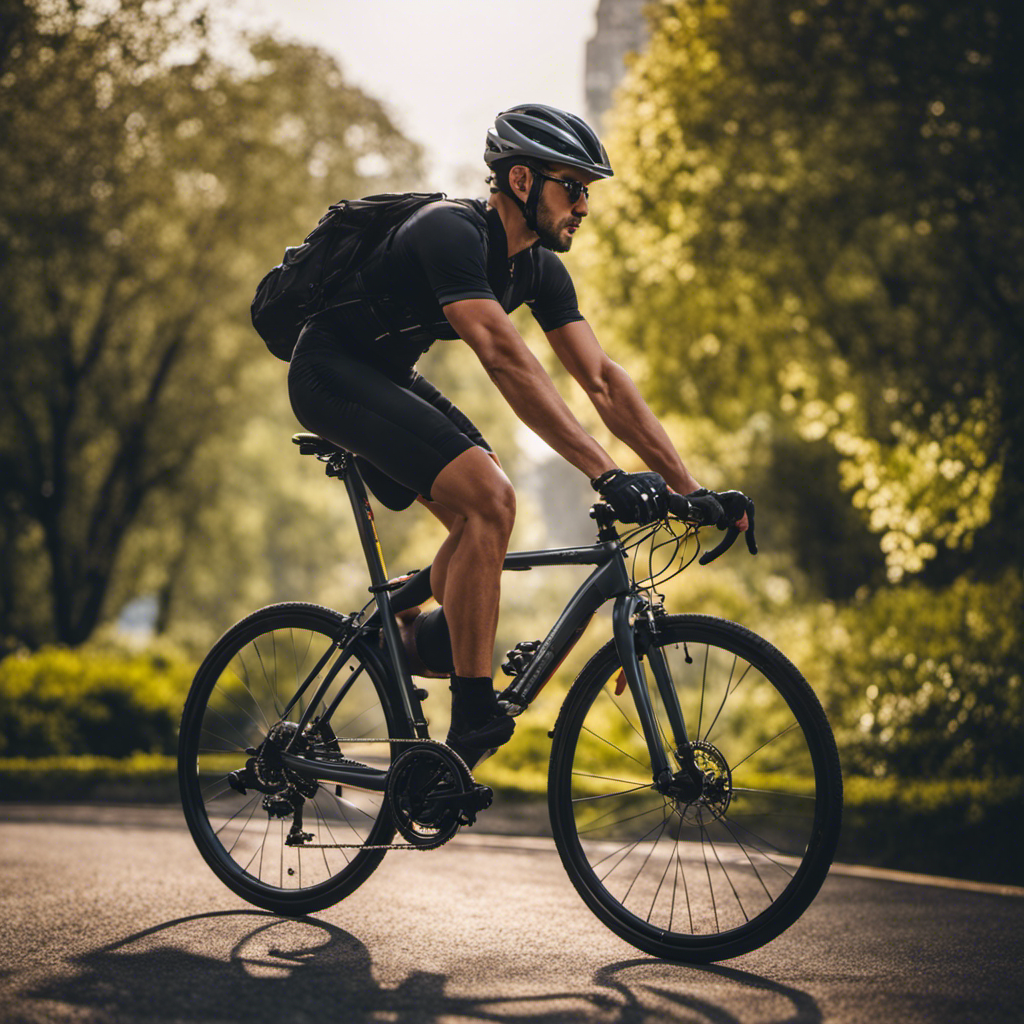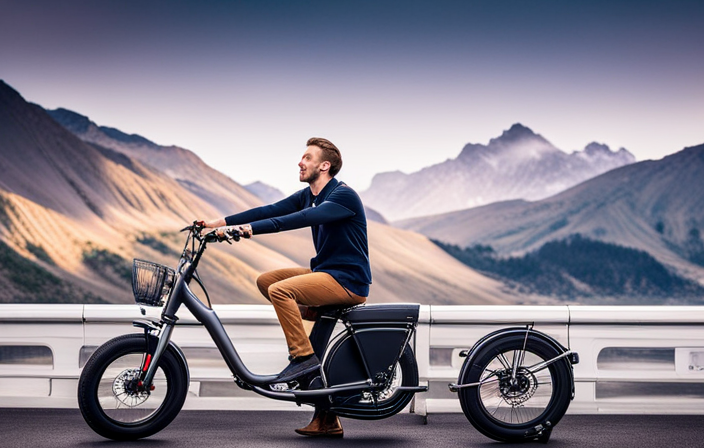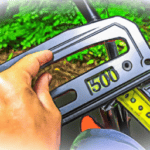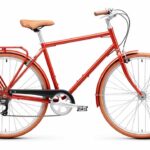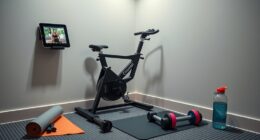Are you ready to revolutionize your daily commute? We’ve got the inside scoop on how to transform your hybrid bike into the ultimate comfort machine.
In this article, we’ll show you seven essential adjustments that will make your ride a dream. From finding the perfect seat height to optimizing brake performance, we’ve got you covered.
Get ready to experience the freedom and liberation of a comfortable commuter hybrid bike ride like never before. Let’s dive in and make those adjustments!
Key Takeaways
- Proper seat height adjustment is crucial for a comfortable commuter hybrid bike experience.
- Handlebar positioning should be adjusted for optimal comfort during rides.
- Regular maintenance and fine-tuning of brakes is necessary to ensure optimal brake performance.
- Choosing the right gear ratio and mastering gear shifting techniques can enhance efficiency and power during commutes.
Proper Seat Height Adjustment
We need to ensure that our seat height is properly adjusted for a comfortable commuter hybrid bike experience. Proper pedal placement is crucial to prevent strain on our knees and optimize our riding efficiency.
To achieve this, we should start by standing next to our bike and adjusting the seat height so that it aligns with our hip bone. This allows for a slight bend in our knee when the pedal is at the bottom of its rotation.
Additionally, saddle angle adjustment is essential for a comfortable ride. We should tilt the saddle slightly downward to prevent sliding forward, as this can cause discomfort and put pressure on sensitive areas.
Handlebar Positioning for Comfort
To ensure comfort while riding a commuter hybrid bike, we should consider the positioning of the handlebars. The handlebar grip and body posture play a crucial role in determining our riding experience.
Firstly, it’s important to find the right handlebar height. Adjust it so that your arms are slightly bent and relaxed, allowing for a comfortable grip. This will help alleviate strain on your wrists and shoulders.
Additionally, consider the handlebar width. It should match the width of your shoulders, ensuring optimal control and stability. Experiment with different handlebar styles, such as flat or riser bars, to find the one that suits your riding style and preferences.
Optimizing Brake Performance
Before hitting the road, let’s fine-tune our brake performance to ensure optimal stopping power and safety while riding our commuter hybrid bike.
Improving braking technique is essential for a comfortable and secure riding experience. Start by adjusting the brake lever position to fit your hand comfortably, allowing for easy reach and control.
Practice applying gradual and even pressure to the brake levers rather than squeezing them abruptly, as this can cause skidding and loss of control.
Additionally, upgrading brake components can significantly enhance your braking performance. Consider investing in high-quality brake pads, which provide better grip and responsiveness. Upgrading to hydraulic disc brakes can also greatly improve your stopping power, especially in wet or challenging conditions.
Finding the Right Gear Ratio
When it comes to finding the right gear ratio for your commuter hybrid bike, there are a few key points to consider.
First, finding the optimal gear ratio is crucial for maintaining a comfortable and efficient riding experience. It allows you to find the perfect balance between power and cadence, ensuring that you can tackle any terrain with ease.
Additionally, having a smooth shifting experience is essential for a seamless ride, so it’s important to choose a gear ratio that allows for quick and precise gear changes.
Optimal Gear Ratio
We typically aim for a gear ratio of 2:1 for a comfortable and efficient commuter hybrid bike experience. Finding the right gear ratio is crucial for optimizing pedaling efficiency and ensuring a smooth ride. Here are three key considerations when selecting your gear ratio:
-
Terrain: Choose a lower gear ratio for uphill climbs to maintain a steady cadence and prevent strain on your muscles. On the other hand, a higher gear ratio is ideal for flat or downhill sections, allowing you to maximize your speed.
-
Riding Style: Your gear ratio should reflect your preferred riding style. If you enjoy a leisurely ride, a lower gear ratio will provide a more relaxed pedaling experience. For those seeking a faster-paced ride, a higher gear ratio will allow for more power and speed.
-
Fitness Level: Consider your fitness level when selecting a gear ratio. Beginners or those with lower fitness levels may benefit from a lower gear ratio to make pedaling easier. As your fitness improves, you can gradually increase the gear ratio to provide a greater challenge.
Efficiency and Power
As cyclists, we can maximize our efficiency and power on a commuter hybrid bike by finding the right gear ratio.
The gear ratio refers to the relationship between the number of teeth on the front chainring and the rear cassette.
By selecting the appropriate gear ratio, we can improve our efficiency and power output while riding.
To achieve efficiency improvement, it’s important to find a gear ratio that allows us to maintain a consistent cadence, or pedal speed, throughout our ride.
This will prevent unnecessary strain on our muscles and help us conserve energy.
Additionally, choosing a gear ratio that allows us to generate adequate power ensures that we can tackle hills and accelerate quickly when needed.
Experimenting with different gear combinations and adjusting as necessary will allow us to find the perfect balance between efficiency and power enhancement.
Smooth Shifting Experience
To ensure a smooth shifting experience on our commuter hybrid bike, it’s important to find the right gear ratio that allows us to effortlessly transition between gears. Here are three key adjustments to improve gear shifting and achieve smoother gear transitions:
-
Finding the Perfect Balance: Experiment with different gear ratios to find the optimal combination of speed and power. Start by pedaling in a gear that feels comfortable, then gradually shift to a higher gear as you gain momentum. This will prevent unnecessary strain on your muscles and allow for smoother gear changes.
-
Proper Chain Alignment: Ensure that your bike’s chain is properly aligned with the gears. Misalignment can cause the chain to slip or jump, resulting in clunky gear shifts. Use the barrel adjuster on your derailleur to fine-tune the alignment and achieve seamless gear transitions.
-
Regular Maintenance: Keep your bike in top shape by regularly cleaning and lubricating the drivetrain. A clean and well-lubricated chain will reduce friction and ensure smoother gear shifts. Additionally, check the gear cables for any signs of wear and replace them if necessary.
Adjusting Suspension for a Smooth Ride
One of the key adjustments we can make for a smooth ride on our commuter hybrid bike is adjusting the suspension. By properly tuning the suspension, we can enhance our comfort and control, allowing us to breeze through our daily commute with ease.
To start, let’s focus on adjusting the fork. This involves finding the right balance between compression and rebound. By adjusting the compression, we can control how the fork responds to impacts, while adjusting the rebound determines how quickly the fork returns to its original position.
Additionally, rear suspension tuning is crucial for a smooth ride. It involves adjusting the sag, which is the amount the rear suspension compresses under the rider’s weight. By finding the optimal sag, we can ensure that the rear suspension provides the perfect amount of support and responsiveness for a comfortable and efficient ride.
Ensuring Proper Tire Pressure
When it comes to ensuring a comfortable and efficient commuter hybrid bike experience, it’s important that we pay attention to and maintain proper tire pressure. Proper tire pressure is crucial for a smooth and safe ride, as it affects the overall performance and handling of the bike.
Here are three essential tips for tire maintenance and puncture prevention:
-
Regularly check tire pressure: Make it a habit to check your tire pressure before each ride. Use a reliable pressure gauge and ensure that the tires are inflated to the recommended PSI (pounds per square inch) as indicated on the sidewall of the tire.
-
Avoid overinflation or underinflation: Both overinflation and underinflation can negatively impact your riding experience. Overinflated tires can lead to a harsh ride and increased risk of punctures, while underinflated tires can cause sluggishness and increased rolling resistance.
-
Inspect tires for wear and tear: Regularly inspect your tires for any signs of wear, such as cracks, bulges, or cuts. Replace worn-out tires immediately to reduce the risk of punctures and ensure optimal grip and performance.
Fine-tuning the Bike’s Weight Distribution
When it comes to fine-tuning the weight distribution of our commuter hybrid bikes, there are a few key points to consider.
First and foremost, achieving optimal weight distribution is crucial for a balanced and stable ride. This not only enhances the bike’s handling and maneuverability but also contributes to a more comfortable and enjoyable experience overall.
Optimal Weight Distribution
We can easily adjust the weight distribution on our commuter hybrid bike to optimize our riding experience. Achieving the right balance of weight can greatly improve our comfort and control while commuting. Here are three essential adjustments to consider:
-
Positioning the Bike Frame: Start by adjusting the bike frame to ensure it’s level. This means the seat and handlebars should be at the same height. A level frame promotes a neutral riding position, preventing excessive strain on our back and shoulders.
-
Adjusting Rider Position: Next, fine-tune our rider position. This involves finding the optimal saddle height and adjusting the handlebars accordingly. A proper fit ensures efficient pedaling and reduces the risk of knee pain or discomfort.
-
Distributing Load: Lastly, distribute our load evenly between the front and rear of the bike. Use panniers or a backpack to carry items, keeping the weight balanced and preventing excessive strain on our back or handlebars.
Handling and Maneuverability
To improve our handling and maneuverability on the commuter hybrid bike, we can fine-tune the bike’s weight distribution and ensure a balanced ride. By adjusting the weight distribution, we can enhance bike stability and make cornering techniques easier and more efficient. To achieve this, we can make the following adjustments:
| Adjustment | Purpose | Technique |
|---|---|---|
| Moving the saddle forward | Shifts weight towards the front wheel, improving control | Loosen the saddle clamp and slide it forward |
| Lowering the handlebars | Increases weight on the front wheel, enhancing stability | Adjust the stem height or replace with a lower one |
| Using wider tires | Provides better grip and traction, enhancing cornering ability | Choose tires with a wider width and lower pressure |
Comfort and Ride Quality
By making adjustments to the bike’s weight distribution, we can enhance our comfort and ride quality on the commuter hybrid bike. Achieving optimal ride comfort starts with understanding the importance of body positioning.
Here are three key adjustments to consider:
-
Saddle Height: Finding the right saddle height is crucial for a comfortable ride. When seated on the bike, your leg should be almost fully extended at the bottom of the pedal stroke, with a slight bend in the knee. This allows for efficient power transfer and reduces strain on the joints.
-
Handlebar Position: Adjusting the handlebar height and reach can greatly impact your comfort. Experiment with different positions to find the one that provides a natural and relaxed arm position. A more upright posture can alleviate stress on the back and neck.
-
Weight Distribution: Balancing your weight between the saddle, handlebars, and pedals is essential for a smooth and comfortable ride. Aim for an even distribution to avoid putting excessive strain on any one area of the body.
Conclusion
Just like a well-tailored suit, properly adjusting your commuter hybrid bike can make all the difference in your riding experience.
By fine-tuning the seat height, handlebar positioning, brakes, gear ratio, suspension, tire pressure, and weight distribution, you can transform your bike into a comfortable and efficient commuting companion.
So, take the time to make these adjustments and let your bike become your trusted steed, carrying you effortlessly through the bustling streets, as you glide towards your destination with ease and joy.
